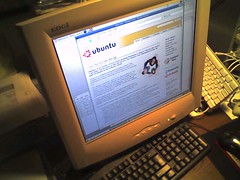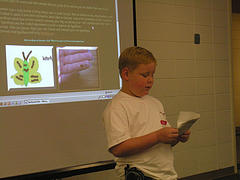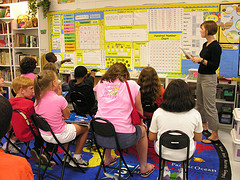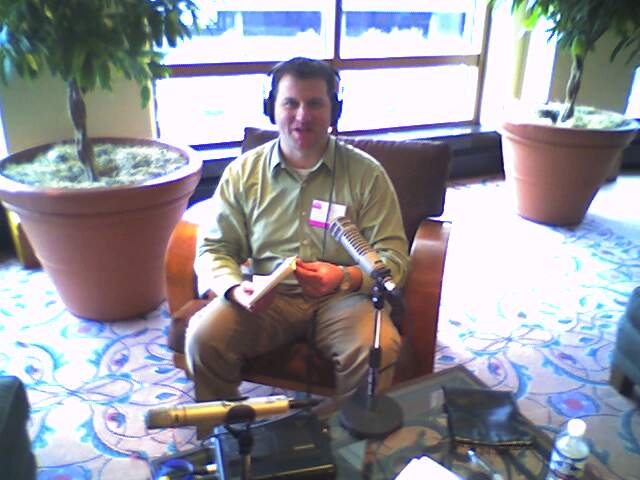The bad news is that the Bush Administration has proposed zeroing ($0) the Enhancing Education Through Technology (E2T2) fund for next year. It isn’t the first time that our president has turned his back on modernizing schools in the United States, and we will hope, pray, and lobby Congress to reinstate a few hundred million dollars of the pathetically low original funding of the program.
This, when, in Saturday’s Weekly Radio Address, the president urged Congress to make his budget cuts permanent, while only weeks ago he signs a bill pushing the ceiling on the national debt to nearly $9 trillion. That’s more than $30,000 for every U.S. Citizen, and one in five of them haven’t reached the age of 15 yet.
OK, enough sport with mr. president. The good news is that 37 state governors reported in their state of the state addresses…
…that their state budgets were projected to be in balance or with a surplus, according to “The Governors Speak: 2006,” a report from the National Governors Association (NGA) summarizing the 2006 state-of-the-state addresses from the governors of 44 states and Puerto Rico. (Ascione)
If you haven’t already, read the April 11 story in eSchoolNews, “State funding to the rescue?“. It will lift to your spirits, especially if you live in Texas, Massachusetts, Florida, Oklahoma, or several other states mentioned in the article for their intentions to invest in education technology.
So if money is beginning to grow again, what’s the case for educational technology. We know that it helps children learn. But lots of things help children learn, and its a hard sell, because it’s a complicated sell. I just don’t see legislators being interested in education strategy. My observations are that elected officials are interested in what’s in it for them and for their consituents. A few more computers, even if they are being carried into classrooms under the arms of every student, just doesn’t get there.
We need to sell a much larger vision of 21st century classrooms where students are learning twenty-first century skills and twenty-first century content, using twenty-first century tools. We need a simple, yet comprehensive picture of teaching, learning, and classrooms that inspires the imaginations of politicians and voters.
It’s a new story that leads to new goals of future citizens, future leaders, future prosperity — enthusiasm about a future so potent with possibilities that we just can’t wait.
OK, I’m getting kind’a carried away here. Tomorrow, I’ll post a slightly more practical examination of “The New Story”.
Ascione, Laura. “State Funding to the Rescue?.” eSchool News Online 11 Apr 2006. 17 Apr 2006 <http://www.eschoolnews.com/news/showStoryRSS.cfm?ArticleID=6258>.

 I feel a need to rant politics here. I believe, and I preach, that the quality of rapid change that we immigrants from the old century are finding so hard to accomodate may actually be a precious opportunity to inspire learning among our students. Part of being, what Alan November calls, fearless learners is being empowered not only with the contemporary tools of learning, but also the responsibility of learning.
I feel a need to rant politics here. I believe, and I preach, that the quality of rapid change that we immigrants from the old century are finding so hard to accomodate may actually be a precious opportunity to inspire learning among our students. Part of being, what Alan November calls, fearless learners is being empowered not only with the contemporary tools of learning, but also the responsibility of learning. I’m carrying on with this discussion, though there seems to be very little conversation regarding… I suspect that it is because many schools are on spring break and that many educators have switched off their computers for finer things. Or it could be that I’m biting bark and totally out to lunch on this one. Regardless, I’m going to trudge along.
I’m carrying on with this discussion, though there seems to be very little conversation regarding… I suspect that it is because many schools are on spring break and that many educators have switched off their computers for finer things. Or it could be that I’m biting bark and totally out to lunch on this one. Regardless, I’m going to trudge along. More to the point of this title of the blog entry, they are master communicators and influencers. They write incessantly, using a language and grammar that they’ve invented. They follow and they lead through their communications. They play their video games for a week, get board, and invent new games to play in the old video game environments. Play is a flat learning engine, powered by the energy of curiosity and and the intrinsic need to communicate and influence.
More to the point of this title of the blog entry, they are master communicators and influencers. They write incessantly, using a language and grammar that they’ve invented. They follow and they lead through their communications. They play their video games for a week, get board, and invent new games to play in the old video game environments. Play is a flat learning engine, powered by the energy of curiosity and and the intrinsic need to communicate and influence.
 I’d like to put some of my thoughts down today, concerning the first two characteristics of the student of a flat classroom — curiosity and self-directed learners. It is often said that students enter our classrooms as curious beings. I suspect that if we truly watched children at play, without the hindrances of classroom regiment, we would also identify characteristics of a self-directed learner. Yet, appearances indicate that somewhere along the way of their elementary and middle school years, childish curiosity and desire to put themselves to learn for its intrinsic value, seems to go away — at least in terms of the learning expectations that are stipulated by our governments, and probably from the perspectives of most middle and high school teachers.
I’d like to put some of my thoughts down today, concerning the first two characteristics of the student of a flat classroom — curiosity and self-directed learners. It is often said that students enter our classrooms as curious beings. I suspect that if we truly watched children at play, without the hindrances of classroom regiment, we would also identify characteristics of a self-directed learner. Yet, appearances indicate that somewhere along the way of their elementary and middle school years, childish curiosity and desire to put themselves to learn for its intrinsic value, seems to go away — at least in terms of the learning expectations that are stipulated by our governments, and probably from the perspectives of most middle and high school teachers. What about an education system that is challenged to prepare children for their future — and it’s not their father’s future. So what about a flat classroom? Traditional education has been an environment of hills. The teacher could rely on gravity to support the flow of curriculum down to the learners. But as much as we might like to pretend, we (teachers) are no longer on top of the hill. The hill is practically gone.
What about an education system that is challenged to prepare children for their future — and it’s not their father’s future. So what about a flat classroom? Traditional education has been an environment of hills. The teacher could rely on gravity to support the flow of curriculum down to the learners. But as much as we might like to pretend, we (teachers) are no longer on top of the hill. The hill is practically gone.  Discussions about The New Story have grown, and it has spread in lots of different directions. As I suggested last week in
Discussions about The New Story have grown, and it has spread in lots of different directions. As I suggested last week in  Last week, I delivered a keynote address at the
Last week, I delivered a keynote address at the